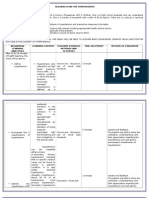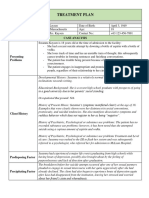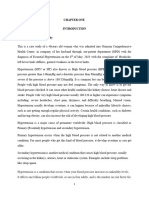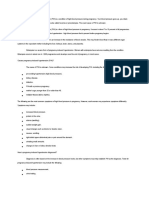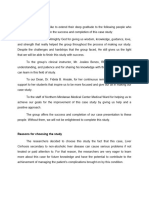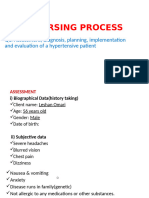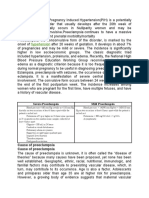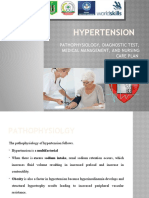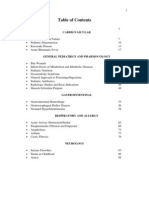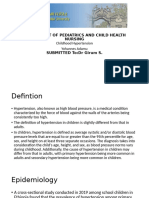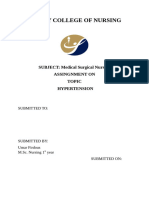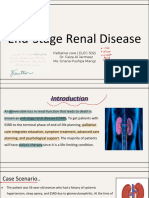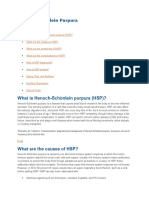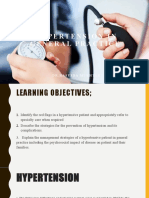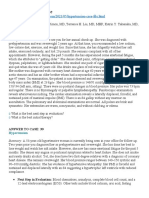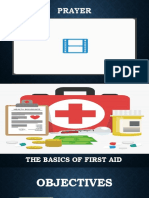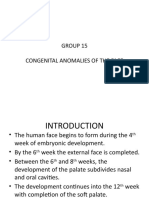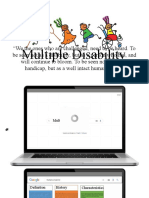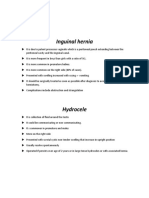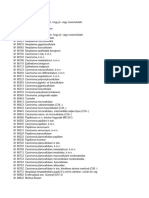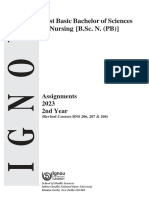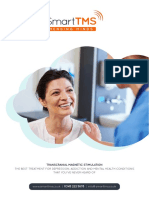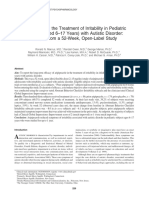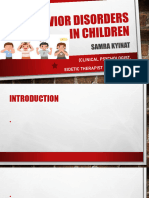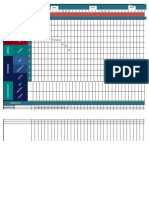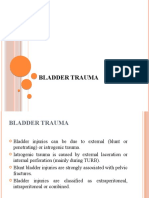0 ratings0% found this document useful (0 votes)
27 viewsNursing Assessment: Nursing Care Plan For Hypertension
Nursing Assessment: Nursing Care Plan For Hypertension
Uploaded by
maheru_chanHypertension is a chronic disease associated with knowledge deficits about diet, lifestyle, medications, and treatment regimens. Nursing assessments for hypertension include taking a patient history, performing a physical exam, and conducting a psychosocial exam. Common nursing diagnoses for hypertension include noncompliance with treatment regimen, fatigue, ineffective coping, impaired tissue perfusion, and risk for injury.
Copyright:
Attribution Non-Commercial (BY-NC)
Available Formats
Download as DOCX, PDF, TXT or read online from Scribd
Nursing Assessment: Nursing Care Plan For Hypertension
Nursing Assessment: Nursing Care Plan For Hypertension
Uploaded by
maheru_chan0 ratings0% found this document useful (0 votes)
27 views1 pageHypertension is a chronic disease associated with knowledge deficits about diet, lifestyle, medications, and treatment regimens. Nursing assessments for hypertension include taking a patient history, performing a physical exam, and conducting a psychosocial exam. Common nursing diagnoses for hypertension include noncompliance with treatment regimen, fatigue, ineffective coping, impaired tissue perfusion, and risk for injury.
Original Title
Hypertension is chronic disease that way
Copyright
© Attribution Non-Commercial (BY-NC)
Available Formats
DOCX, PDF, TXT or read online from Scribd
Share this document
Did you find this document useful?
Is this content inappropriate?
Hypertension is a chronic disease associated with knowledge deficits about diet, lifestyle, medications, and treatment regimens. Nursing assessments for hypertension include taking a patient history, performing a physical exam, and conducting a psychosocial exam. Common nursing diagnoses for hypertension include noncompliance with treatment regimen, fatigue, ineffective coping, impaired tissue perfusion, and risk for injury.
Copyright:
Attribution Non-Commercial (BY-NC)
Available Formats
Download as DOCX, PDF, TXT or read online from Scribd
Download as docx, pdf, or txt
0 ratings0% found this document useful (0 votes)
27 views1 pageNursing Assessment: Nursing Care Plan For Hypertension
Nursing Assessment: Nursing Care Plan For Hypertension
Uploaded by
maheru_chanHypertension is a chronic disease associated with knowledge deficits about diet, lifestyle, medications, and treatment regimens. Nursing assessments for hypertension include taking a patient history, performing a physical exam, and conducting a psychosocial exam. Common nursing diagnoses for hypertension include noncompliance with treatment regimen, fatigue, ineffective coping, impaired tissue perfusion, and risk for injury.
Copyright:
Attribution Non-Commercial (BY-NC)
Available Formats
Download as DOCX, PDF, TXT or read online from Scribd
Download as docx, pdf, or txt
You are on page 1of 1
Hypertension is chronic disease that way,
Hypertension nursing diagnosison nursing care plan for
Hypertension many associated with the Knowledge deficit about Diet, Disease process, Health behaviors,
Medication, prescribed activity, Treatment regime and lifestyle
Nursing diagnosis for hypertension determine bay what we found in nursing assessment, and data from Diagnostic
tests.
Nursing Assessment nursing care plan for Hypertension
Patient history, Elicit a history of previously elevated blood pressure, elevated cholesterol counts, a family history of
hypertension, and the presence of risk factors. Ask the patient about early signs and symptoms, such as malaise,
fatigue, general weakness, or a vague sense of discomfort. Ask if the patient has experienced any loss of vision,
shortness of breath, chest pain, confusion, increased irritability, seizures, transient paralysis or stupor, sleepiness,
visual disturbances, severe headaches, or vomiting
Physical examination, in many cases, the hypertensive patient has no symptoms, and the disorder is revealed
incidentally during evaluation for another disorder or during a routine blood pressure screening program.
Inspection may reveal peripheral edema in late stages when heart failure is present. Ophthalmoscopic
evaluation may reveal hemorrhages, exudates, and papilledema in late stages if hypertensive retinopathy is
present.
Palpation of the carotid artery may disclose stenosis or occlusion. Palpation of the abdomen may reveal a
pulsating mass, suggesting an abdominal aneurysm. Enlarged kidneys may point to polycystic disease, a cause of
secondary hypertension. Systolic or diastolic pressure, or both, may be elevated. An increase in diastolic blood
pressure from a sitting to a standing position suggests essential hypertension, whereas a fall in blood pressure from
the sitting to the standing position indicates secondary hypertension.
Auscultation may reveal an abdominal bruit to the right or left of the umbilicus midline or in the flanks if renal
artery stenosis is present. Bruits may also be heard over the abdominal aorta and femoral arteries or the carotids.
Psychosocial examination. When symptoms are exacerbated, the patient may become anxious or fearful. Since
hypertension can result in changes in lifestyle and perception of body image, assess The patient’s coping
mechanisms
Nursing diagnosis for Hypertension
Primary Hypertension nursing diagnosis is knowledge deficit related to chronic disease management,
Possible nursing diagnosis, which is commonly found in nursing care plan for Hypertension:
Noncompliance: Therapeutic regimen
Fatigue
Ineffective coping
Ineffective tissue perfusion: Cardiopulmonary
Risk for injury
Related posts:
1. Nursing Outcome And Nursing Interventions Nursing Care Plans For Hypertension
2. Nursing Diagnosis Chronic Renal Failure CRF
3. Nursing Diagnosis for Gout/Gouty Arthritis
4. Nursing Diagnosis Renal Calculi/Kidney stones
5. Anemia Nursing Diagnosis
You might also like
- Teaching Plan For HypertensionDocument22 pagesTeaching Plan For HypertensionSheila Mae Alcaide Dagdag80% (15)
- Case Conceptualization - SAMPLEDocument2 pagesCase Conceptualization - SAMPLEKenshin De Los TrinosNo ratings yet
- Heart Failure-1Document12 pagesHeart Failure-1EmilyjNo ratings yet
- Magzine Hypertension 1Document16 pagesMagzine Hypertension 1Iqra UmaimaNo ratings yet
- HCVDDocument5 pagesHCVDkhrizaleehNo ratings yet
- Cute Hypertension and Hypertensive Crisis in Children: A. George KoshyDocument9 pagesCute Hypertension and Hypertensive Crisis in Children: A. George KoshyAimhigh_PPMNo ratings yet
- Pediatric Hypertension: Why The Rise in Childhood Hypertension?Document9 pagesPediatric Hypertension: Why The Rise in Childhood Hypertension?Peace ManNo ratings yet
- NCP PrenatalDocument20 pagesNCP PrenatalemeyyNo ratings yet
- TOBIAS - Nursing Process Paper Fall 2011 - FINAL GRADED Corrections RevBDocument14 pagesTOBIAS - Nursing Process Paper Fall 2011 - FINAL GRADED Corrections RevBToby CerilloNo ratings yet
- HT PDFDocument5 pagesHT PDFmist73No ratings yet
- Nursing Care With EclampsiaDocument40 pagesNursing Care With EclampsiaNadia DesyerianNo ratings yet
- ProgeriaDocument25 pagesProgeriaPiyush JakharNo ratings yet
- Nursing Care For Patient With HypertensionDocument13 pagesNursing Care For Patient With HypertensionSachin MadhukarNo ratings yet
- Essential Hypertension Pro NewDocument60 pagesEssential Hypertension Pro NewWAHEED JUBRILNo ratings yet
- NCP CKD From CaneDocument74 pagesNCP CKD From CaneSheela Khrystyn LeeNo ratings yet
- Beginning of Chapter 2Document4 pagesBeginning of Chapter 2eirelav0902No ratings yet
- NCP For EclampsiaDocument3 pagesNCP For EclampsiaFatma Nor Aljanna Macog100% (1)
- Alterations in Oxygenation 14Document15 pagesAlterations in Oxygenation 14alejandrino_leoaugustoNo ratings yet
- Abdominal DistensionDocument7 pagesAbdominal DistensiondracvbasicNo ratings yet
- HTN Role DevelopmentDocument22 pagesHTN Role Developmentapi-507694117No ratings yet
- Case Presentation: Patient Chart - Mary JohnsonDocument12 pagesCase Presentation: Patient Chart - Mary Johnsonivoneeh_16100% (1)
- CardioDocument4 pagesCardioMarielle RumbaoaNo ratings yet
- Pregnancy Induced HypertensionDocument2 pagesPregnancy Induced HypertensionJohn Lemuel GuevarraNo ratings yet
- Health Teaching PlanDocument10 pagesHealth Teaching PlanMariel Colminas100% (2)
- Case Pres 2ndrotDocument11 pagesCase Pres 2ndrotJoseph Emmanuel CandaNo ratings yet
- تقرير (Hypertension)Document6 pagesتقرير (Hypertension)ayoob.shahed.23.std.nurNo ratings yet
- HypertensionDocument19 pagesHypertensionmr_coolz282344No ratings yet
- Variabilitatea TADocument13 pagesVariabilitatea TADaniel StaniloaieNo ratings yet
- Case Study HPTDocument16 pagesCase Study HPTIQmah RamliNo ratings yet
- HypertensionDocument38 pagesHypertensionmariatheressamercadoNo ratings yet
- Hypertension Advance EnglishDocument24 pagesHypertension Advance EnglishArdelianda AugeslaNo ratings yet
- Reversing Chronic Hypertension Naturally : The Healthy way to Prevent the Silent KillerFrom EverandReversing Chronic Hypertension Naturally : The Healthy way to Prevent the Silent KillerNo ratings yet
- MergeResult 2023 08 21 10 03 52Document29 pagesMergeResult 2023 08 21 10 03 52gadheaniket00No ratings yet
- Pre EclampsiaDocument179 pagesPre EclampsiaAnton RossiniNo ratings yet
- Nursing ProcessDocument13 pagesNursing ProcessojelomaryNo ratings yet
- Team 1Document15 pagesTeam 1fauzi hardyNo ratings yet
- Nursing Care PlansDocument3 pagesNursing Care PlansprinceaszNo ratings yet
- HypertensionDocument11 pagesHypertensionRukaya AlshamiNo ratings yet
- Pregnancy Induced Hypertension: DefinitionDocument7 pagesPregnancy Induced Hypertension: Definitionkristine hinaresNo ratings yet
- Hypertensive Cardiovascular Disease Also Known As Hypertensive Heart Disease Occurs Due To The Complication of Hypertension or High Blood PressureDocument3 pagesHypertensive Cardiovascular Disease Also Known As Hypertensive Heart Disease Occurs Due To The Complication of Hypertension or High Blood Pressurejoanneceline16No ratings yet
- Hypertension: Pathophysiology, Diagnostic Test, Medical Management, and Nursing Care PlanDocument12 pagesHypertension: Pathophysiology, Diagnostic Test, Medical Management, and Nursing Care PlanMaulidyaFadilahNo ratings yet
- Pediatric HandbookDocument201 pagesPediatric HandbookJoseph MensaNo ratings yet
- What Is Pregnancy-Induced Hypertension (PIH) ?Document3 pagesWhat Is Pregnancy-Induced Hypertension (PIH) ?kathyNo ratings yet
- Childhood HypertensionDocument23 pagesChildhood Hypertensionjohn adamu100% (1)
- SPURTY COLLEGE OF NURSING HYPERTENSIONDocument8 pagesSPURTY COLLEGE OF NURSING HYPERTENSIONumarfirdous222No ratings yet
- Rhigh Blood PressureDocument12 pagesRhigh Blood PressureMlumun Kange IyoNo ratings yet
- CABRAL Essential Hypertension Case Presentation and DiscussionDocument9 pagesCABRAL Essential Hypertension Case Presentation and DiscussionCalingalan Hussin CaluangNo ratings yet
- Unit 15Document27 pagesUnit 15jcrd7vdmksNo ratings yet
- Thesis Hypertension PDFDocument7 pagesThesis Hypertension PDFnelowow1vut3100% (2)
- I. Acute Heart Failure: What Every Physician Needs To KnowDocument13 pagesI. Acute Heart Failure: What Every Physician Needs To KnowRubie Ann TillorNo ratings yet
- What Is Henoch-Schönlein Purpura (HSP) ?Document6 pagesWhat Is Henoch-Schönlein Purpura (HSP) ?sakuraleeshaoranNo ratings yet
- HypertensionDocument26 pagesHypertensionArmoured SpartanNo ratings yet
- When To Screen For High Blood PressureDocument18 pagesWhen To Screen For High Blood Pressurefd9rtrydvvNo ratings yet
- Hypertension Case FileDocument6 pagesHypertension Case Filehttps://medical-phd.blogspot.comNo ratings yet
- PihDocument35 pagesPihmark100% (6)
- Corrections INP CASE STUDYDocument59 pagesCorrections INP CASE STUDYNoveeNo ratings yet
- Pregnancy Induced Hypertension Case StudyDocument77 pagesPregnancy Induced Hypertension Case StudyJoe Anne Maniulit, MSN, RN84% (49)
- IntroductionDocument8 pagesIntroductionpuspaNo ratings yet
- Hypertension: Within This GuidelineDocument11 pagesHypertension: Within This GuidelineAdriana OcrosNo ratings yet
- Askep HipertensiDocument23 pagesAskep HipertensiTikaNo ratings yet
- Hypertensive CrisisDocument7 pagesHypertensive CrisisAbdul Hannan Ali100% (1)
- Medical CertificateDocument2 pagesMedical CertificatelekacaNo ratings yet
- Generali - CI 跨越無限保 LionGuardian BeyondDocument24 pagesGenerali - CI 跨越無限保 LionGuardian Beyondjason2211992No ratings yet
- Neurology Clerkship Orientation 2018-19Document32 pagesNeurology Clerkship Orientation 2018-19Elyzza G. AguasNo ratings yet
- Lesson 1 The Basics of First AidDocument70 pagesLesson 1 The Basics of First AidDJ JoeNo ratings yet
- 6.congenital Anomalies of The FaceDocument18 pages6.congenital Anomalies of The FacecollinsmagNo ratings yet
- Pshychometric TestingDocument48 pagesPshychometric Testingchawkat100% (1)
- Abpsych Chapter 1Document4 pagesAbpsych Chapter 1Renz ReyesNo ratings yet
- Conversion (Hysteria)Document76 pagesConversion (Hysteria)Viren SolankiNo ratings yet
- Multiple DisabilityDocument14 pagesMultiple DisabilityJervyn GuiananNo ratings yet
- Trauma Thorax: Oleh: Moch. Achwandi, M.Kep - NS., CWCSDocument52 pagesTrauma Thorax: Oleh: Moch. Achwandi, M.Kep - NS., CWCSMariSstan EM HaNo ratings yet
- Abnormal Psychology Diagnostic Exam (28jan2024)Document7 pagesAbnormal Psychology Diagnostic Exam (28jan2024)Gea Erica GianNo ratings yet
- ASA PS Classifications From The American Society of AnesthesiologistsDocument1 pageASA PS Classifications From The American Society of AnesthesiologistsaffifulichwanNo ratings yet
- The Psychiatric HistoryDocument12 pagesThe Psychiatric HistoryAhmad AltarefeNo ratings yet
- Pediatric Surgery Notes For NursesDocument8 pagesPediatric Surgery Notes For NursesAhmed SamyNo ratings yet
- Anxiety DisorderDocument8 pagesAnxiety DisorderWajeeha JahangirNo ratings yet
- Morphologia - Torzs 3Document16 pagesMorphologia - Torzs 3Eyex97No ratings yet
- BNS 2nd YEAR 2023 ReviseDocument20 pagesBNS 2nd YEAR 2023 ReviseshadabkhanskNo ratings yet
- Smart TMS BrochureDocument8 pagesSmart TMS BrochureSanjay KumarNo ratings yet
- Risk For Ineffective Airway Clearance 1Document8 pagesRisk For Ineffective Airway Clearance 1kint manlangitNo ratings yet
- 1 - Aripiprazole in The Treatment 52 Minggu AutismDocument8 pages1 - Aripiprazole in The Treatment 52 Minggu AutismmirafauziNo ratings yet
- Antidepressants and Antipsychotics NCLEX ReviewerDocument4 pagesAntidepressants and Antipsychotics NCLEX ReviewerRonNo ratings yet
- Disorders of ChildhoodDocument61 pagesDisorders of ChildhoodEdom TesfayeNo ratings yet
- Prosiding Seminar Kesehatan Nasional Lembaga Penelitian Dan Pengabdian Masyarakat Universitas Muhammadiyah Pekajangan PekalonganDocument8 pagesProsiding Seminar Kesehatan Nasional Lembaga Penelitian Dan Pengabdian Masyarakat Universitas Muhammadiyah Pekajangan PekalonganBintari PutriNo ratings yet
- Pathophysiology - AppendicitisDocument5 pagesPathophysiology - AppendicitisAzielle Joyce RosquetaNo ratings yet
- Behavior Disorders in ChildrenDocument35 pagesBehavior Disorders in Childrensabira shakirNo ratings yet
- XXXX XXXXX XX X: Time ### ### ###### Mood ChartDocument4 pagesXXXX XXXXX XX X: Time ### ### ###### Mood ChartMary Bernadette EglosoNo ratings yet
- Bladder TraumaDocument13 pagesBladder TraumaAnusikta PandaNo ratings yet
- Summary PsilocybinDocument1 pageSummary PsilocybintetaNo ratings yet
- Module 09 Written Assignment - Endocrine Disorders GuideDocument6 pagesModule 09 Written Assignment - Endocrine Disorders Guidepeninahototo254No ratings yet
